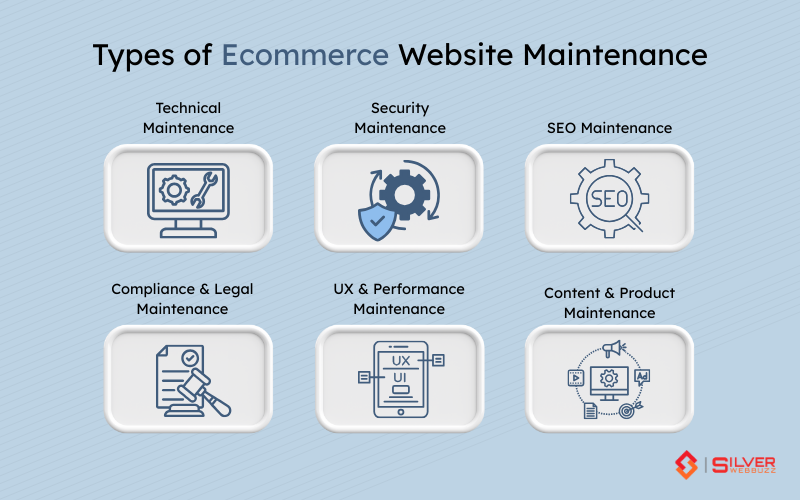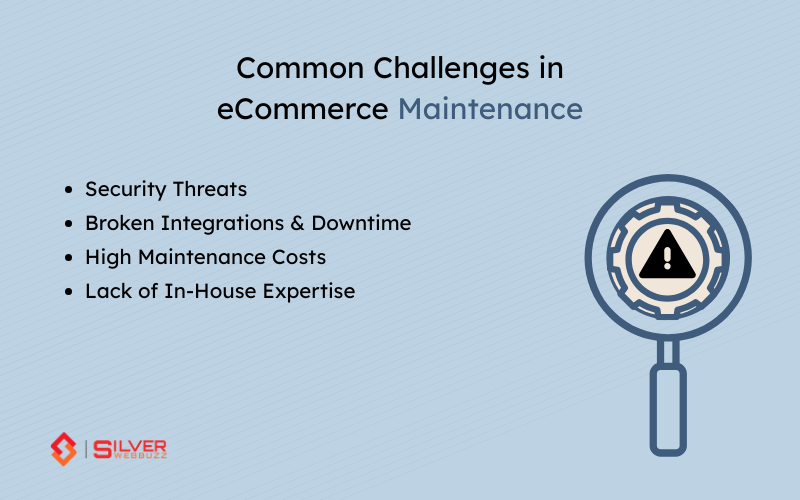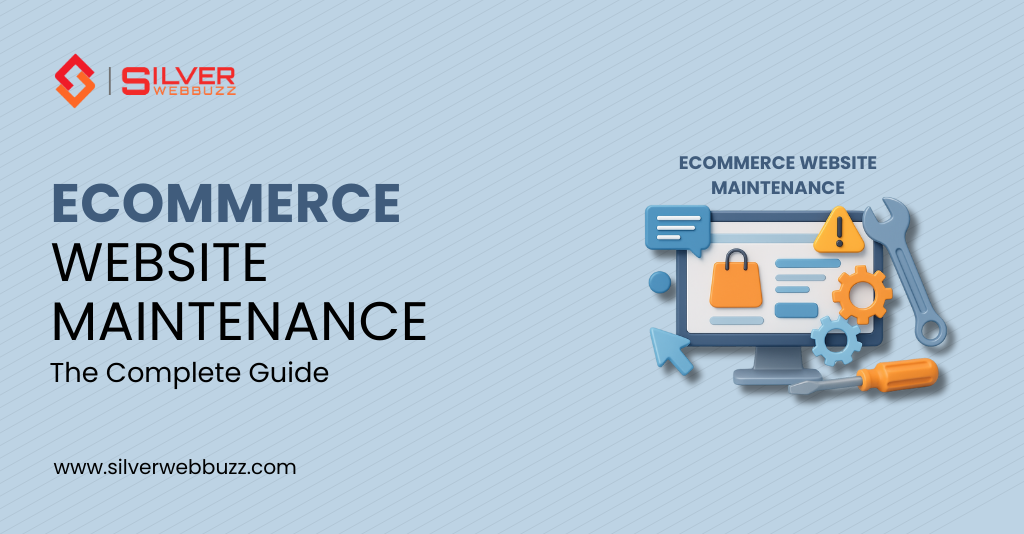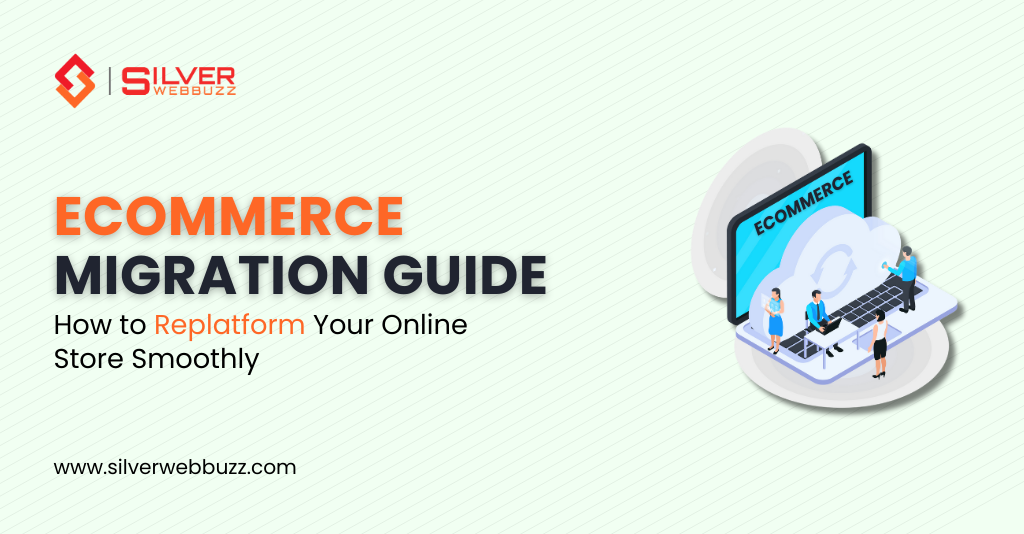Every single minute an e-commerce site is down, glitches, or loads slowly, businesses lose money—sometimes far more than they realize. For example, a small business with annual revenue of $10 million may lose $5,000 (or more) per minute in a downtime scenario. Also, more than 50% of mobile users leave a website if it takes more than 3 seconds to load. Meanwhile, U.S. retail sites take an average of 6.3 seconds to load on mobile—more than double what Google recommends.
In other words, e-commerce websites cannot be “set and forget.” Every broken button, unpatched plugin, and slow page represents lost trust, escaping sales, worse SEO rankings, and greater vulnerability to attacks. Ecommerce website maintenance is not an optional overhead—it’s the foundation of long-term success in the digital marketplace.
In this guide, you’ll learn what ecommerce website maintenance really means, why it matters so much, the types of maintenance you need, how much you might expect to pay, how often to do what, and tools & tips you can put to use right away. If you want to prevent downtime, protect revenue, and keep your customers coming back, the steps in this article will help you build a plan that works.
What Is Ecommerce Website Maintenance?
Ecommerce website maintenance is the continuous process of keeping an online store updated, secure, and fully functional. It ensures that every part of the website—from the shopping cart to the checkout process—works as intended, without errors or interruptions.
At its core, ecommerce maintenance involves monitoring and managing the technical, security, and content aspects of a website so it delivers a smooth experience for visitors and remains compliant with industry standards. This is not a one-time activity but a set of recurring tasks performed weekly, monthly, or as needed.
Scope of Ecommerce Maintenance
- Technical maintenance: updates to hosting, servers, CMS systems, plugins/themes; ensuring uptime; making backups.
- Security maintenance: applying patches, SSL renewal, firewall configuration, malware scanning, ensuring secure payment processes.
- SEO & search maintenance: optimizing meta tags, schema markup, fixing broken links, ensuring pages load quickly, keeping content relevant with keywords.
- Content & product maintenance: updating product descriptions, images, pricing, inventory levels; removing or archiving out-of-stock items; ensuring accurate product data.
- User Experience (UX) & performance: mobile optimization, navigation improvements, optimizing page load times, Core Web Vitals, checking for browser compatibility.
- Compliance & legal maintenance: ensuring privacy policy updates, GDPR or similar data protections, payment security standards (PCI DSS), accessibility rules.
Why Is Ecommerce Website Maintenance Important?
Maintaining an ecommerce website is not just about keeping things running — it directly affects revenue, customer trust, and long-term sustainability. Below are the key reasons why maintaining your online store should be a priority.
Security & Data Protection
- Unpatched software, themes, or plugins leave openings for hackers or malware.
- SSL certificates and secure payments (PCI DSS) protect customers’ personal and financial data; lapses here can lead to data breaches and legal penalties.
User Experience & Performance
- Slow page load times frustrate users; statistics show that 40% of shoppers won’t wait more than 3 seconds for an ecommerce site to load.
- Poor performance on mobile or issues with navigation can increase bounce rates sharply. Users expect smooth checkout, fast browsing, and consistent functionality.
Conversion Rates & Sales
- Every interruption — broken links, malfunctioning buttons, incomplete checkout — leads to abandoned carts and lost sales.
- Even minor “soft downtime” (partial failures or degraded performance) can silently reduce purchases. For example, stores that improved speed by 1 second often saw measurable gains in conversion rates.
SEO & Search Visibility
- Search engines favor sites with reliable uptime, fast load speeds, and correctly working links.
- Frequent errors or downtime degrade crawl ability, which can decrease rankings and lower organic traffic over time.
Financial Loss & Brand Trust
- Downtime is expensive. A report noted that over 30% of outages result in direct revenue loss.
- One ecommerce site reportedly lost at least US$10,000 in potential sales when the website crashed for over 3 hours during a Black Friday event.
- Poor reliability damages customer trust, reduces repeat business, and harms reputation.
Imagine a mid-sized store running a major sale. If the checkout page breaks or the site is unresponsive just during one peak hour, the business can lose thousands of dollars — plus downstream losses from customers who may never return.
Types of Ecommerce Website Maintenance

Ecommerce website maintenance is made up of multiple categories of recurring tasks, each ensuring that your online store runs smoothly, remains secure, and delivers a great customer experience. Below is a detailed breakdown of each type of maintenance and the activities it involves.
1. Technical Maintenance
Technical maintenance keeps the foundation of your ecommerce store stable and functional.
Key Activities:
- Platform updates: Keep your CMS, ecommerce platform (Shopify, WooCommerce, Magento), and plugins up to date to avoid compatibility issues.
- Server monitoring: Track uptime and response time to detect outages early.
- Backups: Schedule daily or weekly backups of databases, media, and order history.
- Error resolution: Fix 404 pages, redirect outdated URLs, and resolve broken scripts.
- Version control: Maintain staging environments to test updates before going live.
Example: Running regular backups can prevent catastrophic data loss if your site is hacked or crashes unexpectedly.
2. Security Maintenance
Security maintenance protects your customers’ personal data and shields your business from breaches.
Key Activities:
- Apply security patches and updates immediately.
- Renew SSL certificates to maintain HTTPS encryption.
- Scan for malware and remove malicious code if detected.
- Use a Web Application Firewall (WAF) to block suspicious traffic.
- Restrict user permissions and enforce strong passwords.
Example: Implementing two-factor authentication for admin accounts can reduce the risk of unauthorized access.
3. SEO Maintenance
SEO maintenance ensures your store remains discoverable in search engines and free from technical SEO issues.
Key Activities:
- Update meta titles, descriptions, and product schema regularly.
- Run site crawls to identify broken internal links or duplicate content.
- Optimize images for faster load times and better rankings.
- Monitor keyword rankings and refresh underperforming pages.
- Submit updated sitemaps to Google Search Console after significant changes.
Example: Checking for broken links once a month ensures that users and search engine crawlers don’t hit dead ends.
4. Content & Product Maintenance
Keeping content accurate builds customer trust and avoids confusion.
Key Activities:
- Add new product listings and remove discontinued ones.
- Update seasonal promotions, banners, and homepage offers.
- Refresh product descriptions and images to improve engagement.
- Keep pricing accurate and inventory levels synchronized with your ERP or POS system.
Example: A fashion store that updates product images seasonally improves customer experience and brand consistency.
5. UX & Performance Maintenance
User experience (UX) and performance maintenance focus on how customers interact with your site.
Key Activities:
- Test checkout flow regularly to detect friction points.
- Optimize for mobile devices and ensure responsive design.
- Review navigation structure for clarity and simplicity.
- Analyze Core Web Vitals (Largest Contentful Paint, CLS, FID) and improve where needed.
- Compress large images and enable caching to reduce page load times.
Example: Even a one-second improvement in page speed can significantly lower bounce rates and boost conversions.
6. Compliance & Legal Maintenance
Compliance tasks ensure you meet regulatory requirements and avoid penalties.
Key Activities:
- Update privacy policies, terms of service, and cookie banners.
- Maintain GDPR, CCPA, or similar data compliance if operating globally.
- Ensure PCI DSS compliance for credit card payments.
- Test accessibility (WCAG 2.1) for users with disabilities.
Example: Regularly auditing your store’s privacy policy helps maintain compliance with changing data protection laws.
Ecommerce Website Maintenance Costs
The cost of ecommerce website maintenance varies depending on your platform, store size, and whether you handle maintenance yourself or hire professionals. Understanding these cost structures helps you budget realistically and choose the right level of support.
1. DIY Maintenance
If you or your in-house team handle maintenance, the main costs are time, software subscriptions, and occasional developer help.
Typical Costs:
- Hosting: $20–$200/month depending on platform and traffic.
- Premium plugins or themes: $10–$50/month (per plugin).
- Security tools: $15–$100/month (firewalls, malware scanners).
- Developer support (as needed): $50–$150/hour for bug fixes.
DIY is affordable but requires technical knowledge, consistent attention, and time — otherwise small issues may be missed.
2. Agency or Freelancer Maintenance
Hiring an agency or freelancer means you outsource regular upkeep. This option suits businesses that want professional oversight without building an in-house team.
Typical Costs:
- Monthly retainers: $500–$2,000/month depending on complexity and hours included.
- Hourly support: $75–$150/hour for ad-hoc fixes or updates.
- Service packages: Many agencies offer bundles that include backups, updates, security monitoring, and monthly reports.
This option is ideal for businesses with steady sales that want peace of mind and predictable monthly costs.
3. Managed Ecommerce Maintenance Services
Managed services provide the most hands-off approach, often covering 24/7 monitoring, security, backups, performance optimization, and technical support.
Typical Costs:
- Comprehensive plans: $1,500–$5,000/month for enterprise-grade solutions.
- Custom contracts: Pricing based on store size, integrations, and SLAs (service level agreements).
This approach is suited for high-traffic stores where downtime or security issues could result in significant revenue loss.
4. Platform-Specific Considerations
- Shopify: Lower maintenance cost since hosting, security, and updates are handled by Shopify. Costs are mostly for theme updates, app maintenance, and occasional development tweaks.
- WooCommerce: Higher DIY workload — you manage hosting, plugin updates, backups, and security. Costs can fluctuate more.
- Magento / Adobe Commerce: Requires technical expertise, usually maintained by dedicated developers or agencies; costlier but highly customizable.
Having a clear idea of costs allows store owners to plan a realistic maintenance budget and choose the right approach—whether it’s self-managed, partially outsourced, or fully managed.
Maintenance Frequency: Weekly, Monthly, Yearly Checklist
A successful ecommerce maintenance plan spreads tasks across different intervals so your team stays consistent without feeling overwhelmed. Here’s a practical schedule you can follow:
Weekly Maintenance
These tasks keep the store running smoothly day-to-day.
- Test order flow: Place a test order to make sure checkout, payments, and confirmation emails work correctly.
- Review key pages: Check homepage, product pages, and cart page for broken elements or slow loading.
- Update inventory: Ensure product quantities and availability are accurate.
- Monitor uptime and performance: Use monitoring tools to catch any downtime quickly.
- Run quick security scan: Look for malware or unauthorized logins.
Monthly Maintenance
These deeper checks help identify issues before they affect performance or customers.
- Plugin and theme updates: Safely update plugins, themes, and platform software after testing on staging.
- Analytics review: Check Google Analytics or GA4 for traffic drops, high bounce rates, or funnel leaks.
- Broken link audit: Identify and fix broken links using SEO tools.
- SEO health check: Review meta tags, schema, and page indexing status in Google Search Console.
- Content refresh: Update product descriptions, blog posts, and promotions.
Quarterly Maintenance
A more thorough review to maintain UX quality and compliance.
- UX and navigation review: Test navigation paths, search function, and filters to ensure easy browsing.
- Performance audit: Use tools like GTmetrix or PageSpeed Insights to measure speed and fix bottlenecks.
- Security audit: Review user roles, permissions, and server logs.
- Backup testing: Restore a backup to ensure files and database are recoverable.
- Accessibility check: Verify compliance with WCAG guidelines for usability.
Yearly Maintenance
Strategic tasks to prepare for the next year.
- Website redesign or refresh: Update design elements to keep the site modern.
- Platform audit: Evaluate whether current ecommerce platform still meets business needs.
- Policy updates: Refresh privacy policy, terms & conditions, and cookie notices.
- Compliance review: Ensure adherence to new regulations (GDPR, PCI DSS).
- Performance benchmarking: Compare metrics year-over-year to track improvements.
Following a schedule like this creates a consistent workflow that keeps your ecommerce store secure, optimized, and customer-friendly throughout the year.
Ecommerce Website Management Services vs Ecommerce Managed Services
Business owners often confuse website management with managed services, but they serve different purposes. Understanding the distinction helps you decide which solution fits your needs.
Ecommerce Website Management Services
Website management services focus on day-to-day operations and growth support for your online store. This includes:
Content updates (products, blogs, promotions)
- SEO optimization and on-page improvements
- Conversion rate optimization (CRO) and analytics review
- Tracking user behavior and suggesting improvements
- Coordinating design updates and feature rollouts
Example: An ecommerce management provider may monitor which products have high cart abandonment and suggest UX tweaks or promotions to boost sales.
Ecommerce Managed Services
Managed services are more technical and infrastructure-oriented. They are ideal for businesses that need 24/7 monitoring and proactive problem resolution.
- Hosting and server management
- Uptime monitoring and quick issue response
- Security patching and firewall management
- Scheduled backups and disaster recovery
- Performance optimization at the server level
Example: A managed service provider will notice if your site goes down at 3 AM, fix the issue before most customers notice, and log a report for your team.
Key Difference
Think of management as the growth engine and managed services as the safety net.
- Management = improving performance and conversions.
- Managed services = preventing downtime and technical failures.
Many businesses use a combination of both for a well-rounded approach: management for strategy and growth, and managed services for stability and reliability.
Tools & Platforms for Ecommerce Website Maintenance
The right tools make ecommerce website maintenance easier, faster, and more reliable. Below is a categorized list of essential tools you can use to automate tasks, monitor performance, and secure your store.
1. Security Tools
Keep your website safe from threats and protect customer data.
- Sucuri: Website firewall, malware removal, and monitoring.
- Wordfence (for WordPress/WooCommerce): Real-time protection against hacking attempts.
- Cloudflare: DDoS protection, SSL management, and CDN for faster delivery.
2. Performance & Monitoring Tools
Track uptime and speed to ensure smooth customer experience.
- Pingdom: Website uptime and performance monitoring with instant alerts.
- UptimeRobot: Free uptime monitoring every 5 minutes.
- GTmetrix: Detailed site speed and performance reports with suggestions for improvement.
3. Backup & Recovery Tools
Automate backups so you can recover your store quickly if needed.
- UpdraftPlus (WooCommerce): Schedule automated backups to cloud storage.
- VaultPress (Jetpack): Real-time backup solution with one-click restore.
- CodeGuard: Continuous backup service with monitoring for file changes.
4. SEO & Site Health Tools
Monitor technical SEO and keep your store search-friendly.
- Google Search Console: Track indexing issues, Core Web Vitals, and keyword performance.
- Screaming Frog: Crawl your site to find broken links and duplicate content.
- Ahrefs / SEMrush: Monitor rankings, backlinks, and perform content audits.
5. Analytics & User Behavior Tools
Understand how users interact with your site to guide improvements.
- Google Analytics 4 (GA4): Analyze traffic sources, conversions, and user journeys.
- Hotjar: Heatmaps and session recordings to spot UX issues.
- Clarity by Microsoft: Free session recording and click tracking.
Common Challenges & How to Overcome Them

Ecommerce website maintenance is not just about fixing issues when they appear — it’s about preventing them. Here are the most common challenges businesses face and practical steps to overcome them.
1. Security Threats
Cybersecurity is one of the top risks for online stores. Attackers exploit outdated plugins, weak passwords, and unprotected servers. A single breach can lead to stolen customer data, legal liabilities, and damaged trust.
How to Overcome It:
- Regular Security Updates: Keep your CMS, plugins, and themes up to date.
- Firewalls & DDoS Protection: Use solutions like Sucuri WAF or Cloudflare to block malicious traffic.
- SSL Certificate Renewal: Ensure your website always uses HTTPS to protect customer transactions.
- Security Scans: Schedule automated scans to detect malware or suspicious code before it causes harm.
2. Broken Integrations & Downtime
Ecommerce sites rely on multiple integrations (payment gateways, shipping APIs, inventory tools). Even one broken connection can stop customers from completing purchases or cause pricing/inventory errors.
How to Overcome It:
- Routine Testing: Check checkout flow, login, and key integrations weekly.
- Staging Environment: Test plugin updates and new features in a staging site before deploying live.
- Uptime Monitoring: Use tools like UptimeRobot or Pingdom to get alerts if your site goes down.
3. High Maintenance Costs
Maintaining security, hosting, backups, and staff support can become costly — especially for small to medium businesses trying to scale.
How to Overcome It:
- Predictable Pricing Models: Consider a monthly ecommerce maintenance plan instead of ad-hoc fixes.
- Cloud Hosting: Choose scalable cloud solutions that adjust costs based on traffic.
- Automation: Automate backups, updates, and monitoring to cut manual work hours.
4. Lack of In-House Expertise
Many businesses don’t have dedicated developers or IT staff, leading to slow issue resolution and delayed updates.
How to Overcome It:
- Outsource to Experts: Partner with an experienced ecommerce website maintenance company or managed service provider.
- Training & Documentation: Equip your team with basic troubleshooting knowledge for first-level support.
- 24/7 Support: Choose vendors who provide round-the-clock monitoring and emergency response.
Trends & Future of Ecommerce Website Maintenance
Ecommerce website maintenance is rapidly evolving. As online shopping becomes more competitive and customer expectations rise, businesses must look beyond routine updates and adopt proactive, data-driven maintenance strategies. Here are the key trends shaping the future:
1. AI-Powered Monitoring & Automation
Manual monitoring is no longer enough for fast-moving ecommerce businesses.
- AI-driven monitoring tools automatically detect anomalies such as sudden downtime, slow pages, or broken checkout processes.
- Predictive analytics forecast potential server overloads or traffic spikes, allowing you to scale resources before issues occur.
- Automated scripts can handle basic tasks like cache clearing, database optimization, and plugin updates — reducing human error.
2. Predictive Maintenance
Borrowed from manufacturing and IT operations, predictive maintenance uses data to anticipate failures.
- Real-time performance tracking helps identify trends like slow server response times.
- Businesses can schedule preventive fixes before customers notice problems, ensuring better uptime and smoother user experience.
3. Focus on Core Web Vitals & User Experience
With Google’s Page Experience signals playing a larger role in SEO, UX-driven maintenance will dominate:
- Monitoring Largest Contentful Paint (LCP), First Input Delay (FID), and Cumulative Layout Shift (CLS) will become standard.
- Ecommerce teams will need to continually optimize images, scripts, and mobile responsiveness to stay competitive.
4. Sustainability & Green Hosting
More brands are prioritizing environmentally responsible maintenance:
- Using green web hosting providers that run on renewable energy.
- Optimizing code and media to reduce server load and energy consumption.
5. Centralized Managed Services
Instead of juggling multiple vendors, businesses are moving toward all-in-one ecommerce management services that combine hosting, security, SEO monitoring, and analytics into a single package for efficiency and cost savings.
How to Choose the Right Ecommerce Website Maintenance Company
Selecting the right ecommerce website maintenance company can make or break your online business. With numerous providers offering e-commerce management services, it’s essential to know what to look for.
Checklist for Choosing a Partner:
- Expertise Across Platforms: Ensure the company has experience with Shopify, Magento, WooCommerce, or your specific platform.
- Security Certifications: Look for compliance with standards like PCI DSS for payment security.
- Service-Level Agreements (SLAs): A good provider guarantees uptime, response times, and recovery plans.
- Scalability: The company should grow with your business, offering advanced services as your store expands.
Questions to Ask Before Hiring:
- What tools and monitoring systems do you use?
- Do you offer 24/7 support?
- Can you provide case studies or client references?
- How do you handle emergencies?
Outsourcing Pros & Cons:
- Pros: Access to expertise, reduced workload, predictable costs.
- Cons: Less in-house control, dependency on a third party.
Choosing the right ecommerce development services ensures your e-commerce site runs smoothly, remains secure, and continues to deliver consistent revenue.
Conclusion
eCommerce website maintenance is the backbone of a successful online store. Regular updates, security checks, and performance improvements not only prevent downtime but also boost SEO and customer trust. By following a structured maintenance plan or partnering with a reliable company, businesses can protect revenue and deliver a seamless shopping experience. In today’s competitive market, consistent care isn’t optional—it’s essential.




